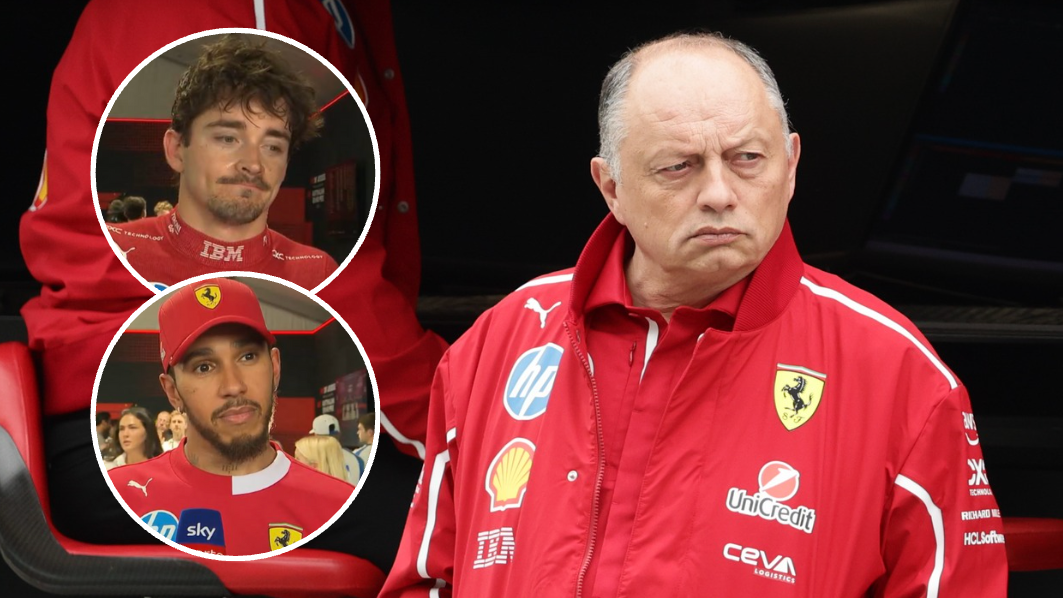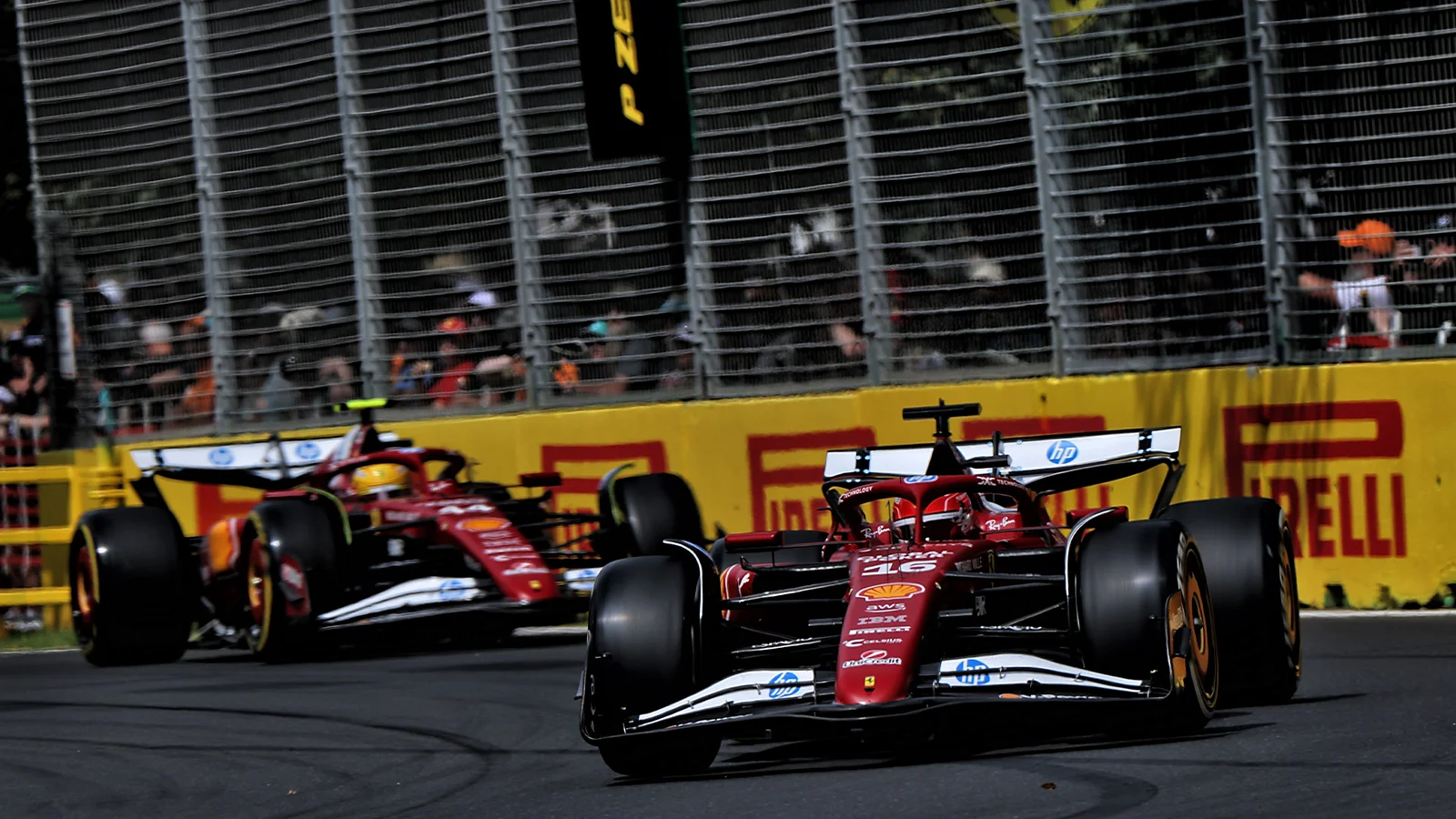In the high-octane world of Formula 1, where every millisecond counts and secrets are guarded more fiercely than crown jewels, Ferrari has just dropped a bombshell that has sent shockwaves through the paddock.
A decision so audacious, so radical, it left its own star drivers, Lewis Hamilton and Charles Leclerc, utterly speechless in the hallowed halls of Maranello.
This isn’t just another race strategy; it’s a high-stakes gamble that could either catapult the Scuderia back into championship contention or see their season go up in flames.
The question on everyone’s lips is not just what Ferrari is doing, but why now, at the most critical juncture of the season?

For months, Ferrari has been a team on the ropes, a shadow of its former glory. Despite flashes of brilliance at tracks like Spa and Monza, the SF-25 has been an enigma, a beast that has been notoriously difficult to tame. The team has been bleeding points to Mercedes in the constructors’ championship, and the pressure has been mounting on team principal Fred Vasseur to turn the tide. The problem, as Ferrari’s internal analysis revealed, was not a lack of raw speed, but a fundamental inability to consistently extract performance from the car across different race formats. One weekend, the car would be a qualifying dream, the next, it would chew through its tires with reckless abandon. Traditional solutions were no longer cutting it, and a more drastic approach was needed.
The answer, it seems, lies in a radical new strategy for the upcoming United States Grand Prix in Austin: a split strategy that will see Hamilton and Leclerc driving two completely different cars. For the first time in recent memory, Ferrari is giving both sides of the garage the freedom to experiment independently, to run entirely separate setup philosophies from the very first lap of practice. This is not just a minor tweak; it’s a fundamental shift in the team’s approach, a calculated risk that could have massive repercussions.
Hamilton’s SF-25 will be a machine built for pure efficiency. A trimmed rear wing, stiffened rear suspension, and a rebalanced weight distribution are all aimed at maximizing straight-line speed and long-run pace for Sunday’s Grand Prix. The car is being optimized for heavy fuel loads and tire management, playing directly to Hamilton’s strengths – his refined braking style and his uncanny ability to manage tire slip under acceleration. In essence, Hamilton is being given the tools to play the long game, to bide his time and strike when the opportunity presents itself.
Leclerc, on the other hand, will be piloting a completely different beast. His car will feature a higher downforce setup, sacrificing straight-line speed for superior control through the technical first and third sectors of the Circuit of the Americas. Softer suspension settings will help maintain consistent lap times as the tires degrade during the sprint race. Ferrari’s simulations predict that Leclerc will qualify strongly and be a force to be reckoned with in the sprint, but his role is far more complex than that. He is, in effect, Ferrari’s live test bed, a rolling laboratory that will provide crucial data on tire behavior for Sunday’s main event.

This is where Ferrari’s plan transcends a simple two-car strategy and enters the realm of a coordinated tactical game. Hamilton and Leclerc will not be fighting against each other on the track; their strategies are designed to be complementary, a symphony of speed and cunning. One will push early, pressuring their rivals into making mistakes, while the other will lie in wait, ready to capitalize on any opportunity that arises. The Circuit of the Americas, with its unique blend of high-speed esses, long straights, and heavy braking zones, is the perfect canvas for this masterpiece of strategy. No single setup can dominate all three sectors, so Ferrari has made the audacious choice to stop searching for the perfect setup and instead wield two different weapons.
The level of detail in Ferrari’s preparation is staggering. Both cars will run modified brake ducts and re-angled sidepod airflow to maintain tire integrity in the scorching Texas heat, which can exceed 40 degrees Celsius. The team has also developed new tire pressure protocols in collaboration with Pirelli, targeting the perfect operating window for both the sprint and the main race. This is a level of surgical precision that speaks to a newfound confidence within the team, a belief that they have finally found the key to unlocking the full potential of the SF-25.
But with great risk comes the potential for great reward, and the stakes could not be higher for Ferrari. If this split strategy works, it will be a validation of months of internal restructuring, new simulator protocols, and the growing influence of Hamilton on the team’s technical direction. It will be a testament to Vasseur’s leadership and his willingness to break from convention. A strong result in Austin could reset the entire narrative of Ferrari’s season, transforming them from a team in crisis to a genuine championship contender.
However, if the experiment fails, the consequences could be devastating. It would expose the razor-thin margin between brilliance and overreach in the cutthroat world of Formula 1. It could create tension within the team, especially if one driver’s setup proves to be vastly superior to the other’s. And it would leave Ferrari back at square one, searching for answers in a season that is rapidly slipping away.

The sprint format in Austin will provide a swift and brutal verdict on Ferrari’s gamble. There will be no hiding behind excuses or weather variables, just pure execution under pressure. As the F1 world descends on the Circuit of the Americas, all eyes will be on the scarlet cars of Ferrari. Will their bold strategy deliver a double podium, or will it backfire spectacularly? The answers are about to unfold, and the ramifications will be felt long after the checkered flag has fallen. One thing is for certain: this is a weekend of F1 that you will not want to miss.